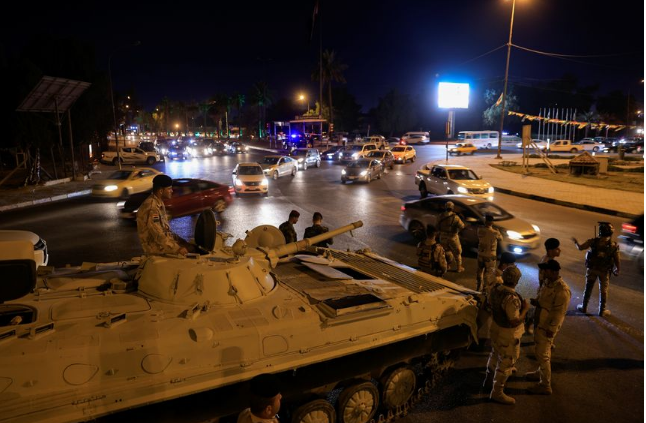Iraqi officials are grappling with how to contain Iran-backed militias after a drone attack on the Iraqi premier’s residence highlighted the enduring threat the paramilitary groups pose.
In the first sign that mediation efforts were making progress, several militia groups agreed to condemn Sunday’s strike and cooperate with government investigators after meeting with Iraq’s president and other officials, senior Iraqi officials said early Tuesday.
The militias have denied responsibility for the attack on the residence of Prime Minister Mustafa al-Kadhimi, who wasn’t hurt. U.S. officials have said an unspecified Iran-backed Iraqi militia was likely behind it. Iran has disavowed the attack and sent a top general to Baghdad to ease tensions. No other group has claimed responsibility for the assault.
The strike put a spotlight on how militia groups pose a threat to Iraqi institutions and underscore how difficult they are for their Iranian sponsors to control, said observers of the militias in and outside of Iraq. The paramilitary forces, part of a broader movement called the Popular Mobilization Units, have wielded enormous influence over Iraqi security and institutions since they helped vanquish Islamic State. But their political parties were dealt a defeat in Iraq’s parliamentary election last month, casting uncertainty over their continued role in the country.
“The Iran-backed militias sent a very clear message that they are willing to create chaos if they are not allowed to be part of the government-formation,” said Hamdi Malik, an expert on the militias at the Washington Institute for Near East Policy, a think tank.
Iran’s Islamic Revolutionary Guard Corps funds, trains and arms some militia groups in Iraq but it remains unclear how much direct control Tehran has over the militants. Some in Tehran now fear the behavior of the Iraqi militia allies could undermine planned negotiations with the Biden administration over a return to the international Iran nuclear agreement, Iranian officials said.
Iranian officials have scrambled to deflect blame. Iranian Gen. Esmail Qaani, a top IRGC leader who oversees the unit that deals with foreign fighting forces, visited Baghdad on Monday, according to an Iraqi militia official and an Iranian official. The Iranian official said Gen. Qaani was in Baghdad as part of de-escalation efforts.
“We have had to tell the Americans, through the Iraqis, that we have nothing to do with these attacks,” said an Iranian diplomat.
Since the Oct. 10 vote, the militias have been fighting to maintain their influence within the state and intimidate Iraqi officials into giving them a voice in the next government. The militia groups launched protests that resulted in clashes with security forces outside of Baghdad’s secure Green Zone last Friday, killing at least one protester.
Cracking down on the powerful militias is unrealistic, observers say, leaving the Iraqi government with little choice but to negotiate with them.
“It seems that Qaani has lost control over some of the groups,” said Ihsan al-Shammari, head of the Iraqi Center for Political Thought in Baghdad.
The militias include hard-line groups that are backed by Iran and have sworn to drive the U.S. out of the country. They escalated their battle against American forces after the U.S. killed Iranian Gen. Qassem Soleimani and Iraqi militia leader Abu Mahdi al-Mohandes in an airstrike in January 2020.
During Sunday’s attack, two drones attacked Mr. Kadhimi’s residence in Baghdad’s secure Green Zone. One rocket landed on the roof without exploding, while the other blasted the doors off the building and injured several security officers, Iraqi officials said.
Diplomats at the nearby U.S. Embassy, already on high alert because of demonstrations organized by the militias outside the Green Zone, went into a duck-and-cover order during the strike, U.S. officials said.
U.S. officials said it was unclear to what extent the attack on the prime minister’s office was coordinated or supported by Iran. The modus operandi was consistent with previous attacks in recent months by Iraqi militias that are backed by Iran’s IRGC, the U.S. officials said.
The Iran-backed paramilitaries have increasingly used drones to launch attacks on bases that house U.S. forces. The IRGC taught militia groups how to use and assemble the drones from off-the-shelf technologies, say U.S., European and Iranian officials.
In another act of escalation, a drone-and-rocket attack hit a remote U.S. base at al-Tanf in Syria on Oct. 20, ending a relative lull in attacks over the previous months. No one was injured.
The attack on Mr. Kadhimi was the most brazen move yet, though some observers said the militia groups risk a backlash. Mainstream Shiite politicians and even the leader of a political bloc affiliated with the militia movement condemned the attack on the prime minister’s office. An array of foreign powers have put pressure on militias to de-escalate.
“They’re lashing out in a way that is harming them,” said Lahib Higel, a Baghdad-based senior analyst at the International Crisis Group.








































admin in: How the Muslim Brotherhood betrayed Saudi Arabia?
Great article with insight ...
https://www.viagrapascherfr.com/achat-sildenafil-pfizer-tarif/ in: Cross-region cooperation between anti-terrorism agencies needed
Hello there, just became aware of your blog through Google, and found ...